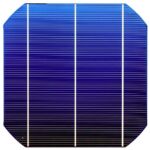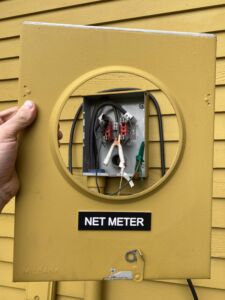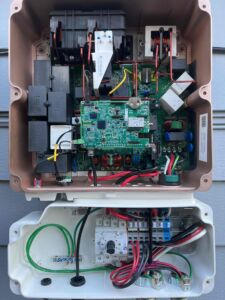Developed in the late 19th century, photovoltaic PV solar powers our lives, and our homes. While the science of photovoltaics hasn’t changed since then, the technology certainly has come a long way.
But what’s behind the science of photovoltaics, and more interestingly, how does a solar panel work?
Like any concept, it’s best to start with the fundamentals. For photovoltaics, that’s the PV cell.
QUICK LINKS
- A photovoltaic cell
- A solar inverter
- Washington net metering program
- Oregon net metering program
- The real profit margin in your PV system
- On-grid solar system
- Off-grid solar system
- Photovoltaic (PV) solar components
A photovoltaic cell
We’re all familiar with solar panels (also called solar modules), but did you know that solar panels are made up of individual solar cells? Anywhere between 60 and 72 cells make up a solar panel. When connected together, multiple panels form a solar array. 
Among other materials, each cell is constructed with two layers of silicon: one positively charged layer, and one negatively charged. These silicon layers act as semiconductors, producing an electrical field due to the polarity between positively and negatively charged atoms.
When light hits a solar panel, photons (particles of light) knock electrons free from positively charged silicon atoms. The displaced electrons move towards the negatively charged layer, creating an electrical current. At this point, direct current (DC) is generated, which is not compatible with powering a home. Instead, DC current is converted to usable alternating current (AC) with the help of a solar inverter.
However, if battery storage has been installed along with solar panels, then it’s necessary that generated electricity pass through a charge controller before the inverter. By regulating the voltage and current coming from the solar panels, the charge controller ensures that the solar battery does not overcharge, which can lead to battery failure.
A solar inverter
A solar inverter does exactly as the name suggests; it converts DC power to AC power for use in the home. There are a few solar inverter configurations, but the string inverter is the oldest and most common invert type on the market.
Most PV systems in use today are tied to the traditional power grid. This configuration saves homes and businesses money because excess energy can be “banked” with the utility provider.
In 2005, Governor Christine Gregoire signed senate bills 5101 and 5111 making Washington arguably the most progressive state in the union in terms of renewable energy production. The bills allow utility companies to pay up to $2,000 per year for the energy produced through renewable means, and write off the amount they pay in state tax.
Washington Net Metering Programs
Since March of 1998, Washington state utilities have been required to provide net metering programs that monitor the production of solar electricity, wind, or small hydroelectric power. Utilities issue credits back to the producer if the electricity generated is more than the electricity used.
Here are some links to online information about net metering programs
Oregon Net Metering Programs
Beginning in 1999, Oregon’s net metering program requires utilities, including investor-owned, public utility districts, municipalities, and cooperatives to provide customers with a means to offset energy purchases.
In billing periods during which the utility delivers more kWh to the customer site than it receives from the on-site renewable project, the customer is billed for each kWh-based charge, plus standard monthly charges. If the customer sends more kWh to the utility than it receives, the kWh credit is carried over for up to 12 months. [Source]
Here are some links to online information about net metering programs
The real profit margin in your PV system
More so than any credit you might receive from your utility company, the biggest benefit of your PV electric system is going to come in the money that you don’t pay on your utility bill. PV systems can provide as much as 1,200 Kilowatt hours per 1,000 watts of PV panel installed providing significant savings on your utility bill.
On-Grid Solar Systems
On-grid solar systems are tied into the standard electric utility system and supplement your power needs. When the system generates more power than you use, the excess power is put back into the power grid for use by other utility customers. In Washington State, the utilities are required to compensate consumers/producers for the power put back into the grid. A straight on-grid system is dependent on the utility to function so solar panels will stop producing electricity in a blackout. The addition of battery storage will allow the system to light a home or business for the life of the battery during an outage.
Off-Grid Solar Systems
Off-grid solar systems are primarily used in rural areas without standard electric service. They are dependent on battery storage to supply power during hours when the sun is not out or not bright enough to supply power for all of the user’s needs. In most cases, off-grid systems require more careful monitoring of electrical usage.
Photovoltaic (PV) solar Components
Solar Panels (also known as the PV array) are the most visible and defining portion of the system and are rated by the watts of electricity they can produce in ideal conditions. Two thin layers of semiconductors are sandwiched together within the cell. The semiconductors react to the photons in sunlight by generating a small DC current which is then transferred into the system where is can be prepared for use by the consumer. Modern solar panels are lightweight and able to withstand inclement weather conditions including hail stones in most cases.
The PV disconnect is essentially a circuit breaker for the system that can be thrown to stop the flow of electricity from the PV arrays and allow for maintenance.
Charge Controllers protect the batteries in the system from overcharging by stopping the power flow from the PV array when the battery is sufficiently charged.
Battery storage stores the energy created by the PV array for later use.
System monitors (also called the battery monitor) give readings on how much power is available within the system.
Main DC Disconnects allow for the system to be shut down between the battery and the inverter and prevent electrical fires within the system.
The inverter converts power from the DC current created by the PV array into AC power that can be used in your home.
The breaker panel is the control point for your home’s electrical system.
